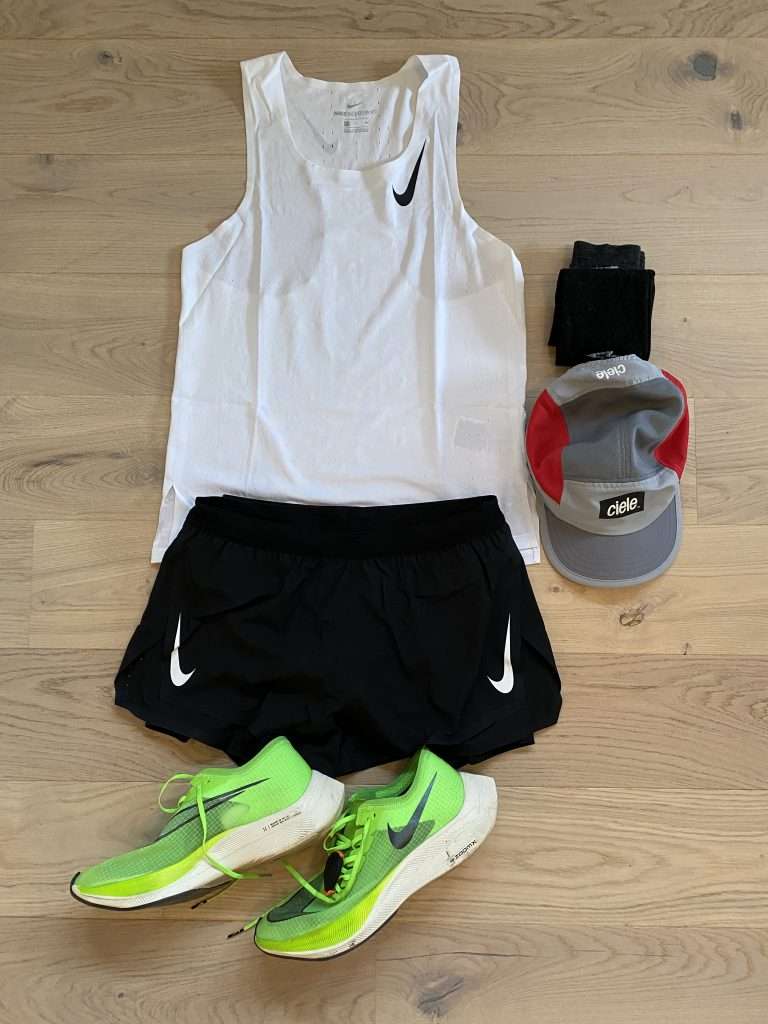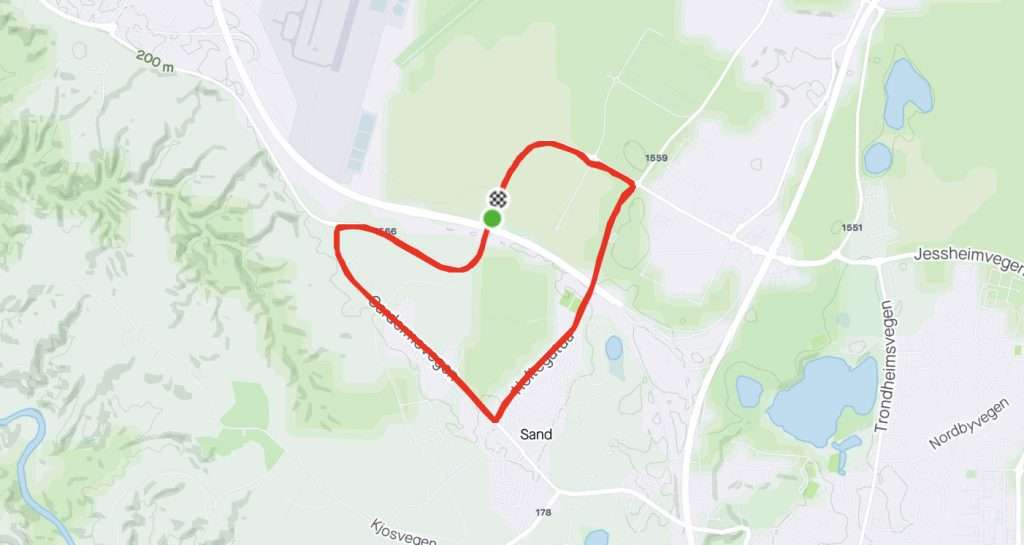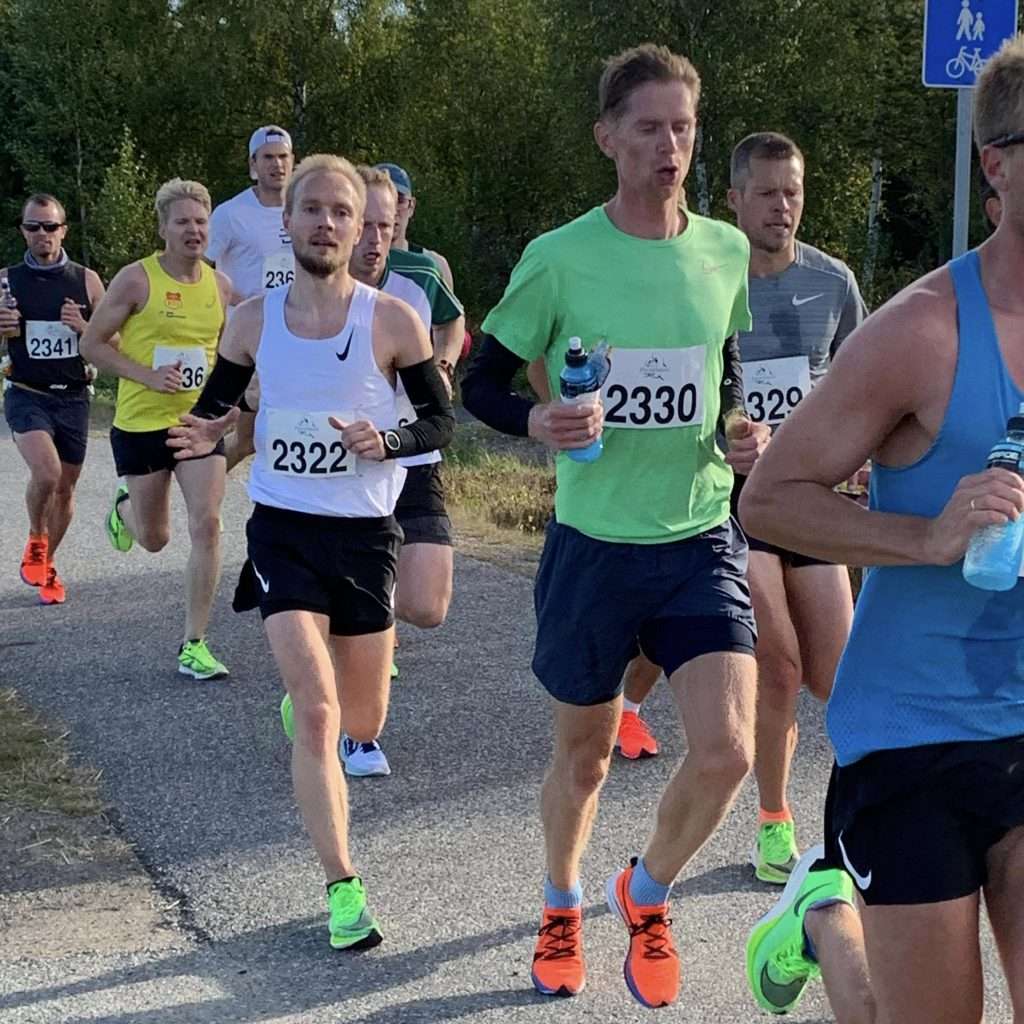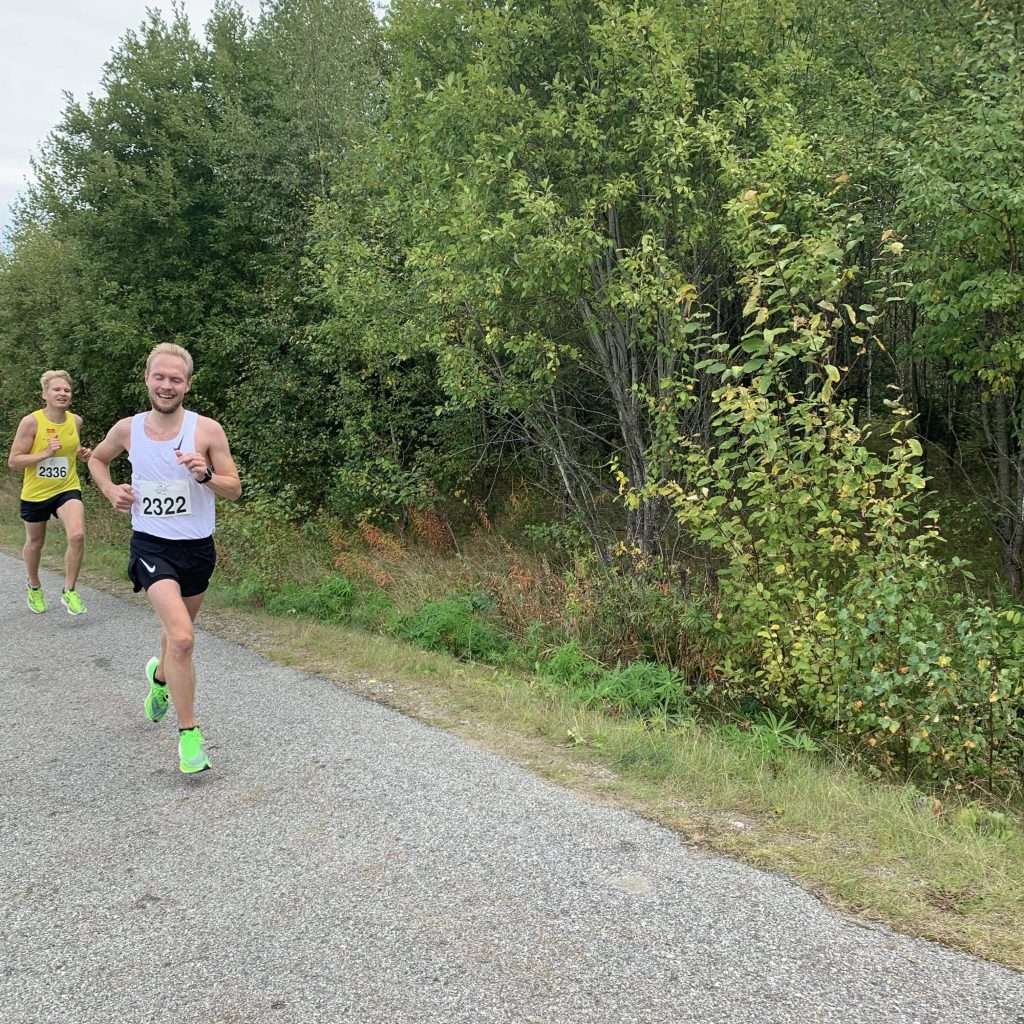If a single race should symbolise this odd year, Perseløpet “Boston” Maraton 2020 would be a strong contender. What other circumstances than the year 2020 could enable a local marathon with limited spots to become the go-to goal race for every hobby jogger and weekend warrior in the country who considers their running more or less serious business?
When the guy who arranges this race announced early in the summer that he would put on two marathons this fall, the relief was palpable among a big group of runners. It turns out, the exotic locations, hotel beds and big-city crowds aren’t the essential parts of running a marathon. The actual act of covering 42 195 metres on foot, as fast as possible, is. And, as many people have discovered this year, you can do that just about anywhere.
With the number of available spots on the starting line capped by the local and national restrictions related to COVID-19, the bibs sold out quickly. I caught the announcement early and could have my pick between running in the middle of September or October. I picked the former, citing the better chances of decent race day weather as the deciding factor — but in all honesty, I probably just wanted to get through this marathon block as quickly as possible.
September 13th was, of course, the planned date for the COVID-postponed 2020-edition of the Boston Marathon. That never materialised, and thus it was I found myself running a tiny marathon in Norway put on as an option to runners who wanted to run their virtual Boston Marathon in a real race. What a time to be alive.
Background
The setting for this race couldn’t be any more different from the previous marathon I ran. Almost exactly a year ago, I ran the Berlin Marathon. Everything went wrong in the taper leading up to that race — and, despite finishing that race in a respectable 2:42:40, it marked the beginning of my most challenging period as a runner to date.
I overcome a health issue that sidelined me for weeks, only to face a knee injury that sidelined me for months. Old acquaintances will remember that I battled runner’s knee back in the winter of 2019, and this was another match-up against the same pain. Only on this go, it was all the more persistent.
The result was that I didn’t get back to proper and consistent running training post-Berlin Marathon until April 2020. The best way to describe that half-year period is a lot of cross training on the elliptical, sprinkled with a bit of jogging on the treadmill, many false starts, and the inevitable disappointment that follows.
The onset of a pandemic turned out to be a blessing in disguise for my running. Without races on the horizon, there was less pressure to get back into shape as quickly as possible. Instead, I was able to take my time and appropriately manage my training load, and increase it sensibly.
Through April, I was able to get back to proper training. I kept mileage at a moderate level, averaging between 80-100 kilometres (50-60 miles) per week. Workouts consisted of mostly threshold work and hill repeats. Although I was finally training at a decent level, the knee still threatened to break down at any point. I did a fair bit of training on the treadmill, as that seems to alleviate the load.
My focus in May and June was to improve my performances in 5k and 10k time trials on the track. The training centred around VO2 Max-specific workouts — or the “interval” intensity in the parlance of Jack Daniels. By the end of June, I ran 34:34 for a 10k solo time trial. I was slightly disappointed, as I felt my training indicated better. Regardless, it was strong enough that I embarked into marathon training confident of bettering my 2:42:40 personal best.
Training
Leading up to this race, I opted for a relatively short, ten-week marathon specific training block. And with two weeks of tapering, that gave me eight weeks to get marathon fit.
I kept the plan simple and stayed close to what I knew by basing it mostly on the principles from Pfitzinger’s Advanced Marathoning. The main ingredients were a threshold workout, and mid-week medium-long run, and a long run every weekend. My planned weekly mileage was between 125 and 150 kilometres (75 – 95 miles).
With a more condensed training cycle, I decided to drop the VO2 Max sessions at the end of a Pfitzinger marathon block. Instead, I prioritised running around my goal race pace, mixing in low-end threshold workouts and long runs with significant portions at marathon pace. The reasoning was that I wanted to become more comfortable and efficient running at this pace, as I had done very little work in this range.
The first six weeks of training went almost exactly according to plan. I got through the planned mileage and workouts. However, as I approached the tail end of the hard work, everything went a bit off the rails.
After failing to get through a threshold session on Friday, I closed out week six by absolutely crashing my long run. After deciding to cut the planned run short, I slowed down to a crawl during a significant climb. Soon unable to run at all, I realised that my legs were not going to carry me the 10 kilometres of the fastest route home.
Sometimes you’re just lucky, though. As I walked past a bus stop shortly after, I noticed that the hourly bus would come by soon. So there I was, riding the bus back home after a failed long run, three weeks out from a marathon.
At this point, I decided to pull the emergency brake. It was clear that my overall load was too high. With the benefit of hindsight, I underestimated the toll of starting a new job. I am convinced that a lower training load from the beginning of August, when the job change took place, would have provided a more manageable training stimulus, and left me more fit on race day.



Taper and a 10k Tune-up Race
In response to the collapse, I reduced my weekly mileage over the last three weeks. Unable to get a read on how my body was feeling, I decided to race a 10k two weeks out from the marathon.
Had I pulled the brakes in time? If the result ended up being way off where I thought my fitness was at this point, the answer was no. I prepared myself to accept the fact, with the implication being that I would have to pass on the marathon in favour of letting my body recover.
The 10k went alright. I passed the 5k mark in 17:13 and felt like I had a lot left in the tank. But as soon as I started to increase the pace, it got tough. I finished in 34:11, which was a new personal best, but just about where I had to be at this point. And I was, frankly, quite disappointed to yet again miss out on sub-34 for the 10k.
During my last two weeks of training, I decided to get rid of my heart rate monitor. Continually checking to see how my heart rate lined up compared to pace and perceived effort was messing with my head. Instead, I ran only to feel. And, for the most part, I felt fine. I convinced myself that y body was in decent shape and that I was setting myself up for a strong marathon performance.
Pre-race
Ahead of my marathon in Berlin last year, the plan was to eat absolutely anything and everything the last few days ahead of the race. And I executed it to perfection. Pasta, pizza, burgers, fries, chocolate and candy — you name it, I ate it. And it worked very well on race day.
I wanted to repeat my performance this time around. The only problem was that, as my running volume decreased, so did my appetite. To the point that over the week of the race had trouble eating what I would during a typical training week. Nevertheless, I had faith in my in-race nutrition strategy, and that it would surely get me through the race.

The morning of the race, I met up with my friend and training partner, Stian. We trained together ahead of Berlin last year, and the first part of the lead up to this race. Unfortunately, a leg injury ended his chances of running this race. I was very thankful to have him along as support, but I sure would have preferred to race alongside him.
In practical terms, a local race is significantly less demanding compared to travelling abroad. The drive to the start area took less than an hour, and we arrived 45 minutes before the start gun. No big crowds, and no rush suits me just fine. I changed and got ready in the car, and swallowed a Maurten gel before jogging a few hundred meters to the starting line.
Race
The forecast had indicated perfect weather conditions for running fast. Around 10 C / 50 F degrees and light cloud cover. Unfortunately, the wind was a bit stronger than expected, and this left me in a pickle. Do I go out with the group aiming to dip under 2:40? Or, do I trust my fitness and try to run alone to increase my chances of running as fast as possible. By my estimate, I thought myself capable of running 2:36-mid if everything went right.
Standing on the start line, I opted for the more conservative approach by dropping down to the second starting group and run with the 2:40 group. With the wind expected to pick up even more throughout the race, I thought this was the only sensible option.

The course is an almost entirely flat 6 051 metres long heart-shaped loop, with two 90-degrees turns. A full marathon, in other words, consisted of just shy of seven laps around the course. It only makes sense, then, to recap the race in seven parts.
Lap One — 6 051 metres (22:54)
Lap time: 22:54 — Lap pace: 3:47/km / 6:05/mile
I went out with the group that counted 12-15 runners who all came here to try and run a marathon in under two hours and forty minutes. Around 25 runners went out ahead of us, so all-in-all it was as fast a start field as you could hope to find.
To maximise the advantage of running in a group, I tucked safely into the back end. But — having watched Eliud Kipchoge’s pacing formation when he broke two in Vienna — I did, of course, always make sure to have at least one or two runners behind me. That’s a joke, but I did comment to one of the other runners that I felt like Kipchoge sitting pretty in the middle of the group.
Lap Two — 12 102 metres (45:59)
Lap time 22:55 — Lap pace 3:47/km / 6:05/mile
The lead pacer is a strong runner, and to has a personal best of 2:28 for the marathon. Working at this pace should be a breeze for such a high-calibre runner, but his metronomic pacing was still impressive. The first two laps were within a second of each other, and precisely at the group’s goal pace.
I remained at the back of the group and felt reassuringly comfortable at this pace. The wind did, however, start to pick up as we embarked on the second lap. My choice of sticking with the group was looking more and more like the correct call.
My in-race nutrition plan was a carbon copy of what worked so well in Berlin: One gel every 30 minutes, and water at every aid station. There were no aid stations for this race, however, so I had placed water bottles at strategic locations around the course. Stian would also offer up bottles and gels as I passed him.

Lap Three — 18 153 metres (1:08:32)
Lap time 22:43 — lap pace 3:44/km / 6:00/mile
Shortly after going out for the third lap, I moved to the front of the group. I wanted to see if anyone else in the group would be interested in increasing the pace slightly. A couple of guys, who treated the race as long run, agreed to increase the speed, and catch the wind up-front.
One other runner joined us as we split from the big group. The wind had picked up yet another notch at this point. I was glad that we had two guys up front taking the brunt of it.
Diligent about my nutrition, I consumed my second Maurten gel on the hour. I was feeling good and chatting away with the other guy who was racing.
Lap Four — 24 204 metres (1:31:10)
Lap time 22:38 — lap pace 3:44/km / 6:00/mile
“Five laps to go!” the other guy said as we set out on our fourth go around the course. I corrected him, saying that if he were running the marathon, four more would do, before adding “heck, we’re almost done!”
The two guys up front were doing a terrific job of setting the pace. Instead of aiming for even splits, they let us know that they would try to keep the effort steady by slowing a bit into the wind, and then pick it up with the wind in our back. The net result was spot on what we had ordered per lap.
During this lap, our group swelled in size from four to six. One runner dropped down from a pack just ahead, and another joined us from behind. One of them planned to drop out between 30-35 kilometres, while the other intended to finish. The more, the merrier!
Lap Five — 30 255 metres (1:53:42)
Lap time 22:32 — lap pace 3:43/km / 5:59/mile
A spectacular collapse usually starts with a single, wrong decision. Mine came just after embarking on the fifth lap when I didn’t pick up a bottle from Stian. I wanted to finish up my 90-minute gel before drinking, and I knew I had dropped a bottle just a few hundred metres up the road.
I know from experimenting in training that when running at a moderate to high intensity, it is pivotal for me to hydrate appropriately after taking in nutrition. Time and time again, I’ve experienced nausea and debilitating stomach cramps when not being sufficiently diligent about my water intake.
Despite all this, I somehow ended up missing that water bottle. I didn’t make too much of it as it happened, but this was without question a critical point of my race. Because I had already finished the two bottles further up the course, it would be a full lap, more than 20 minutes, before I got my hands on more water.
Regardless of this slight mishap, I was still feeling confident. Around halfway through the lap, I aired the idea that we should increase the pace another notch as we set out on the penultimate lap. Thankfully, the other guys were not exactly overjoyed by the though. Because a moment after I had brought up the idea, I knew that my joyride was coming to an end.
It felt as if a switch turned. Keeping up the pace felt, out of the blue, that more challenging. A nagging feeling of nausea came creeping on. I dropped down behind the others and braced myself for war.
Lap Six — 36 306 metres (2:16:17)
Lap time 22:35 — lap pace 3:43/km / 5:59/mile
The thing is, you can’t turn the tide once you’ve missed the boat on your nutrition and hydration in a marathon. Starting the sixth lap, I grabbed a bottle and drank as much as I could, hoping that I could still turn it around.
I could not turn it around. The sensation of nausea kept growing. I knew that I should absolutely, definitely not skip the gel at the two-hour mark. But, convinced that if I tried to force it down, I would have to stop and puke it back up, I said to hell with it.
While the rest of the group were still looking good, hanging on at the back took everything I had at the moment. And with a kilometre to go on the sixth lap, they slowly started to drift away from me. There is nowhere to hide when you’re on your own 35 kilometres into a marathon.
Lap Seven — 42 195 metres (2:39:34)
Lap time 23:17 — lap pace 3:56/km / 6:20/mile
I was fading fast physically, and my mental strength had altogether abandoned me as I ventured out for one more go around the course. A sip of Redbull left me dry heaving. Pain reverberated through my legs with every step, from the soles of my feet and up to my hips.
Going through the potential outcomes of the race in my head, I saw no chances for a decent ending. At the rate I was deteriorating, I did not think I had any chance of bettering my personal best, let alone breaking 2:40. I resigned to the fact this would be a disappointing end to an overall disappointing running season.
One thing I do not do, however, is to give up. The only real feeling of disappointment after a race comes from knowing that you didn’t give it everything. Now, without going too deep into a psychological profile of myself, it is fair to say I am all too familiar with that feeling. But when it comes to running, however, I have found that it is so easy to avoid it. All you have to do is keep pushing.

So I kept pushing. And, to my surprise, my pace never dropped as much as my strained running suggested. Thanks to the fantastic Race Screen data field on my watch I didn’t have to rely on shoddy end-of-race mental arithmetics to see that I was still hanging on for a sub-2:40 finish. Barely, but hanging on nevertheless.
Surprised by my ability to stem the decay, I regained a bit of confidence heading into the final kilometres. Every step hurt, but every step was getting me closer to becoming a 2:39-marathoner — which at the moment sounded like a whole other level compared to being a 2:42.marathoner.
Three or four runners blazed past me over the final mile, but I didn’t care. Compared to the reality I had accepted just a few moments ago, this was going to end successfully. A new personal best and breaking 2:40? Yes, please!
Post-race
I stopped the watch as I passed the finish line, and seeing it paused at 2:39:34; I knew that I had done it. It, in this case, not having been much of a goal leading up to the race. Because I had, quite frankly, taken it for granted. Right at this moment, however, above or below 2 hours and 40 minutes felt like it was the difference between complete success and utter failure.
After spending a few minutes resting flat out in a ditch, I hobbled back to the car. Though it didn’t bother me as I ran, the race had taken its toll on my knee. It felt as bad as it ever had.
I told Stian that he would be driving home. After stopping to buy a couple of cans of Coke, we talked about the race for a few minutes. After that, we switched subjects to the only thing that matters: Our next training block.
Like this?
Let me know by sending me an email at lc@run161.com.
